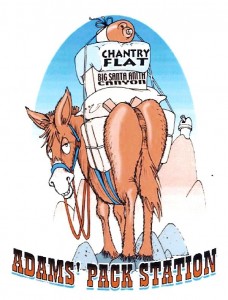 A new “History Lives Here” historical marker showcasing vintage and recent photographs and descriptions of the history of the last remaining mule pack station in the Angeles National Forest – Adams’ Pack Station — will be unveiled at 2 p.m. Sunday, April 17, as part of the station’s 75th anniversary celebration featuring live music and pulled pork sandwiches near the Chantry Flat picnic area at the end of Santa Anita Canyon Road.
A new “History Lives Here” historical marker showcasing vintage and recent photographs and descriptions of the history of the last remaining mule pack station in the Angeles National Forest – Adams’ Pack Station — will be unveiled at 2 p.m. Sunday, April 17, as part of the station’s 75th anniversary celebration featuring live music and pulled pork sandwiches near the Chantry Flat picnic area at the end of Santa Anita Canyon Road.
This is the seventh marker dedicated by the Arcadia Historical Society in less than four years.
The special dedication of the Marker in the area of the station and store, which is also a celebration of five years of ownership by Deb and Sue Burgess, will include local political officials and historians, and residents and visitors of Santa Anita Canyon. It will take place between live acoustic performances by John M from 12 noon – 2 p.m., and Cross Town Cowboys from 2:30 p.m. – 4:30 p.m.
The public is invited to participate and enjoy pulled pork sandwiches made to order in a Dutch oven.
The barn and two-room bunkhouse/store that are still being utilized at Adams’ Pack Station in 2011 were built in 1936 by J.P. Steele, who was the first to obtain a special use permit for a pack station, outfitter store and parking lot at the end of a new road paved to Chantry Flat in 1935. Steele owned First Water Camp in the streambed directly below Chantry in the Angeles National Forest.
For the next three-quarters of a century, the station’s donkeys and mules would be the lifeline for supplies to three active resorts and about 200 cabins accessible only on foot in Big Santa Anita Canyon.
Frank Adams bought the pack station in the fall of 1938 and soon hired his brother Bill. Bill and his wife Lila packed supplies, delivered mail, brought out garbage, sold ice cream and soda, greeted visitors and generally took care of the canyon for 35 years.
In 1984, the Adams’ sold the station to Bill’s nephew Dennis Lonergan and his wife, Jody, who ran the station for 15 years. Bouts with nature and the economy forced the Lonergan’s to sell the station and move to the city in 1999.
When Kim Kelley sold the station after five years of natural disasters and the closure of the road for nearly two years, canyon cabin owners Deb Burgess and her mother Sue Burgess restored the Adams name to signify a return to the Adams’ business model with the help of day-to-day general manager Richard Conforti and other volunteers.
Under their stewardship the pack station has launched a web site and has become a popular gathering place for hikers and families to enjoy the expanded merchandise and food offerings of the general store and myriad activities, including regularly-scheduled outdoor music programs, those pulled pork sandwiches, animal petting, and guided hikes.
The series of Historical Markers are part of the non-profit Society’s mission to create broader public awareness of noteworthy historical events, people, and landmarks in Arcadia.
The Society’s first Historical Marker was presented during the Centennial Celebration of First Avenue Middle School in October 2007. The second was dedicated in May 2008 near the peacock fountain at Los Angeles County’s Arcadia Park, and the third in July 2008 to mark the original City Hall on the northwest corner of Huntington Drive and First Avenue.
Three Markers were dedicated in 2009, beginning with Number Four on April 29 at the Woman’s Club of Arcadia on First Avenue, followed by two dedications during 75th Anniversary celebrations at the Arcadia Chamber of Commerce on July 16, and Santa Anita Park on opening day, Dec. 26 .
Upcoming Markers tentatively planned include Lucky Baldwin’s original Oakwood Hotel and nearby train depot on First Avenue at Santa Clara, and the property along Huntington Drive that has been the location for the Pony Express Museum, the Flamingo Hotel and Santa Anita Inn
The Society would like to thank the City of Arcadia for co-funding many of the Markers, including Adams’ Pack Station, which was installed by the station.
Gene Glasco is president of the Arcadia Historical Society. The Historical Marker Committee is chaired by Scott Hettrick with members Carol Libby and Sandy Snider.
